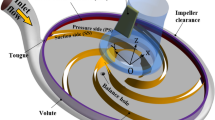Abstract
The understanding of hydraulic behavior in the hydro turbine requires the detailed study of fluid flow in the turbine. Previous methods of analyzing the numerical simulation results on the fluid machinery are short of intuitiveness on energy dissipation. In this paper, the energy dissipation was analyzed based on the entropy production theory. 3-D steady flow simulations and entropy production calculations of the reduced hydro turbine were carried out. The results indicated that the entropy production theory was suitable for evaluating the performance of the hydro turbine. The energy dissipation in the guide vanes area weighted nearly 25% of the whole flow passage, and mainly happened at the head and tail areas of the vanes. However, more than half the energy dissipation occurred in the runner, mostly at the leading edge of runner blade and the trailing edge of runner blade. Meanwhile, close to 20% of the energy dissipation occurred in the elbow. And it can be concluded that the method of entropy production analysis has the advantages of determining the quantity of energy dissipation and where the dissipation happens.
Similar content being viewed by others
References
Liu S H, Li S L, Wu Y L. Pressure fluctuation prediction of a model kaplan turbine by unsteady turbulent flow simulation. J Fluids Eng, Trans ASME, 2009, 131(10): 1011021–1011029
Zhang L X, Wang W Q. Intrinsic features of turbulent flow in strongly 3-D skew blade passage of a francis turbine. J hydrodyn, 2007, 19(1): 92–99
Qian Z D, Yang J D, Huai W X. Numerical simulation and analysis of pressure pulsation in Francis Hydraulic Turbine with Air Admission. J Hydodyn, 2007, 19(4): 467–472
Zhang H C, Schmandt B, Herwig H. Determination of loss coefficients for micro-flow devices: A method based on the second law analysis (SLA). Proceedings of the ASME Micro/Nano Scale Heat and Mass Transfer International Conference, Shanghai, 2009, vol 2. 545–552
Herwig H, Gloss D, Wenterodt T. A new approach to understanding the influence of wall roughness on friction. J Fluid Mech, 2008, 613: 35–53
Kaluri R S, Basak T. Entropy generation due to natural convection. Energy, 2011, 36: 5065–5080
Gloss D, Herwig H. Wall roughness effects in laminar flows: an often ignored though significant issue. Exp Fluids, 2010, 49: 461–470
Ferziger J H, Peric M. Computational Methods for Fluid Dynamics. Berlin: Springer, 2002
Naterer G F, Camberos J A. Entropy Based Design and Analysis of Fluids Engineering Systems. Boca Raton, FL: CRC Press, 2008
Bejan A. Entropy Generation Through Heat and Fluid Flow. New York: John Wiley, 1994
Bejan A. Entropy generation minimization: the method of thermodynamic optimization of finite-time systems and finite-time processes. Boca Raton, FL: CRC Press, 1996
Schmandt B, Herwig H. Internal flow losses: A fresh look at old concepts. Fluid Eng, 2001, 133(5): 1–10
Kock F, Herwig H. Local entropy production in turbulent shear flows: A high Reynolds number model with wall functions. Heat Mass Transfer, 2004, 47: 2205–2215
Mathieu J, Scott J. An Introduction to Turbulent Flow. Cambridge: Cambridge University Press, 2000
Author information
Authors and Affiliations
Corresponding author
Rights and permissions
About this article
Cite this article
Gong, R., Wang, H., Chen, L. et al. Application of entropy production theory to hydro-turbine hydraulic analysis. Sci. China Technol. Sci. 56, 1636–1643 (2013). https://doi.org/10.1007/s11431-013-5229-y
Received:
Accepted:
Published:
Issue Date:
DOI: https://doi.org/10.1007/s11431-013-5229-y




